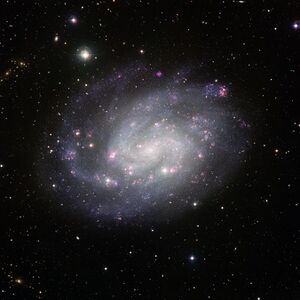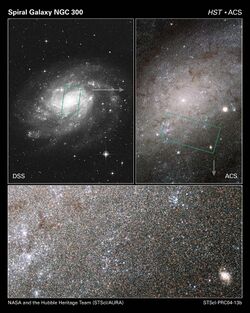Astronomy:NGC 300
| NGC 300 | |
|---|---|
 Image of NGC 300 from ESO's La Silla Observatory | |
| Observation data (J2000 epoch) | |
| Constellation | Sculptor |
| Right ascension | 00h 54m 53.5s[1] |
| Declination | −37° 41′ 04″[1] |
| Redshift | 144 ± 1 km/s[1] |
| Distance | 6.07 ± 0.23 Mly (1.86 ± 0.07 Mpc)[2][a] |
| Apparent magnitude (V) | 9.0[1] |
| Characteristics | |
| Type | SA(s)d[1] |
| Mass | (2.9 ± 0.2) × 1010 M☉ |
| Apparent size (V) | 21.9′ × 15.5′[1] (94,000 light-years in diameter) |
| Other designations | |
| PGC 3238[1] Caldwell 70 | |
NGC 300 (also known as Caldwell 70) is a spiral galaxy in the constellation Sculptor. It is one of the closest galaxies to the Local Group, and probably lies between the latter and the Sculptor Group. It is the brightest of the five main spirals in the direction of the Sculptor Group.[2] It is inclined at an angle of 42° when viewed from Earth and shares many characteristics of the Triangulum Galaxy.[3] It is 94,000 light-years in diameter, somewhat smaller than the Milky Way, and has an estimated mass of (2.9 ± 0.2) × 1010 M☉.[4][5]
Nearby galaxies and group information
NGC 300 and the irregular galaxy NGC 55 have traditionally been identified as members of the Sculptor Group, a nearby group of galaxies in the constellation of the same name. However, recent distance measurements indicate that these two galaxies actually lie in the foreground.[6] It is likely that NGC 300 and NGC 55 form a gravitationally bound pair.[7]
Distance estimates
In 1986, Allan Sandage estimated the distance to NGC 300 to be 5.41 Mly (1.66 Mpc).[8] By 1992, this had been updated to 6.9 Mly (2.1 Mpc) by Freedman et al.[2] In 2006, this was revised by Karachentsev et al. to be 7.0±0.3 Mly (2.15±0.10 Mpc).[9] At about the same time, the tip of the red giant branch (TRGB) method was used to produce an estimate of 5.9±0.4 Mly (1.82±0.13 Mpc) using edge detection and 6.1±0.4 Mly (1.87±0.12 Mpc) using maximum likelihood.[2] These results were consistent with estimates using near-infrared photometry of Cepheid variables by Gieren et al. 2005 that provided an estimate of 6.1±0.2 Mly (1.88±0.07 Mpc).[2] Combining the recent TRGB and Cepheid estimates the distance to NGC 300 is estimated at 6.07±0.23 Mly (1.86±0.07 Mpc).[a]
NGC 300-OT
On a CCD image obtained on May 14, 2008, amateur astronomer L.A.G. Berto Monard discovered a bright optical transient (OT) in NGC 300 that is designated NGC 300-OT.[10] It is located at RA: 00h 54m 34.552s and DEC: −37° 38′ 31.79″[11] in a spiral arm containing active star formation.[12] Its broad-band magnitude was 14.3 in that image. An earlier image (from April 24, 2008), taken just after NGC 300 reemerged from behind the Sun, evidenced an already brightening OT at ~16.3 magnitude.[12] No brightening was detected on a February 8, 2008 image or on any earlier ones.[12] The transient's peak measured magnitude was 14.69 on May 15, 2008.[12]
At discovery, the transient had an absolute magnitude of MV ≈ −13, making it faint in comparison to a typical core-collapse supernova but bright in comparison to a classical nova.[10][12] Additionally, the photometric and spectroscopic properties of the OT imply that it is not a luminous blue variable either.[12] Since its peak, brightness dropped smoothly through September 2008 while becoming continuously redder.[12] After September 2008, brightness continued to fall at a lower rate in the optical spectrum but with strong Hα emissions.[12] Further, the optical spectrum is mostly made up of fairly narrow Hydrogen Balmer and Ca II emission lines coupled with strong Ca II H&K absorption.[10] Research into historical Hubble images provide an accurate upper bound on the progenitor star's brightness.[10] This suggested a low-mass main sequence star as progenitor with the transient resulting from a stellar merger similar to red Galactic nova V838 Monocerotis.[10] Analysis of historical images of the area of the OT suggest with 70% certainty that the progenitor formed in a burst of stars around 8–13 Myr ago and implies the progenitor's mass to be 12–25 M⊙ assuming the OT is due to an evolving massive star.[11]

thumb|NGC 300 by GALEX, in ultraviolet light. However, in 2008 a bright mid-infrared progenitor to the transient was discovered in historical Spitzer data. This was a star that was obscured by dust, with energy distribution analogous to a black-body of R ≈ 300 AU and radiating at T ≈ 300 K with Lbol ≈ ×106 L⊙. This demonstrated that the transient was associated with an energetic explosion of a low-mass ≈ 10 M⊙ star. The transient's low luminosity as compared to typical core-collapse supernova, combined with its spectral attributes and dust covered properties, make it nearly identical to NGG 6946's SN 2008S.[10]
The spectrum of NGC 300-OT observed with Spitzer shows strong, broad emission features at 8 μm and 12 μm. Such features are also seen in Galactic carbon-rich protoplanetary nebulae.[10]
SN 2010da
On May 23, 2010, Monard discovered another transient object of 16th magnitude, denoted as SN 2010da.[13] The optical transient was detected 15".9 west and 16".8 north the center of the galaxy at coordinates 00 55 04.86 −37 41 43.7.[14]
Two sets of independent follow-up spectroscopy data suggested that this was again another optical transient rather than a supernova, possibly an outbursting luminous blue variable star according to one spectrum,[15][16] as earlier predicted from the nature of the candidate mid-infrared progenitor.[17] The transient faded by 0.5–0.7 mag in 9 days, much faster than the 2008 transient in NGC 300.[18]
Other Supernovae
SN 2020acli (type IIn-pec, mag. 18.4) was discovered on 12 December 2020.[19]
Binary black hole system
The x-ray source at the core of NGC 300 is designated NGC 300 X-1.[20] Astronomers speculate that NGC 300 X-1 is a new kind of Wolf-Rayet black hole binary system similar to the confirmed such system IC 10 X-1.[20] Their shared properties include an orbital period of 30 hours.
WO star
There is an oxygen-sequence Wolf-Rayet star (WO4 type), known as STWR 13, located in one of the bright H II regions in NGC 300.[21]
Notes
- ^ Average (1.845±0.125, 1.86±0.07) = ((1.845 + 1.86) / 2) ± ((0.1252 + 0.072)0.5 / 2) = 1.86 ± 0.07
References
- ↑ 1.0 1.1 1.2 1.3 1.4 1.5 1.6 "NASA/IPAC Extragalactic Database". Results for NGC 300. http://nedwww.ipac.caltech.edu/cgi-bin/nph-objsearch?objname=NGC+300&img_stamp=yes&extend=no.
- ↑ 2.0 2.1 2.2 2.3 2.4 Rizzi, L.; Bresolin, F.; Kudritzki, R.-P.; Gieren, W. et al. (2006). "The Araucaria Project: The Distance to NGC 300 from the Red Giant Branch Tip Using HST ACS Imaging". The Astrophysical Journal 638 (2): 766–771. doi:10.1086/498705. Bibcode: 2006ApJ...638..766R.
- ↑ Vlajić, M.; Bland-hawthorn, J.; Freeman, K.C. (2009). "The Abundance Gradient in the Extremely Faint Outer Disk of NGC 300". The Astrophysical Journal 697 (1): 361–372. doi:10.1088/0004-637X/697/1/361. Bibcode: 2009ApJ...697..361V.
- ↑ Westmeier, T.; Braun, R.; Koribalski, B. S. (2011-02-01). "Gas and dark matter in the Sculptor group: NGC 300". Monthly Notices of the Royal Astronomical Society 410 (4): 2217–2236. doi:10.1111/j.1365-2966.2010.17596.x. Bibcode: 2011MNRAS.410.2217W.
- ↑ "NGC 300, a spiral galaxy in Sculptor". 8 July 2014. http://annesastronomynews.com/photo-gallery-ii/galaxies-clusters/ngc-300/.
- ↑ Karachentsev, I.D.; Grebel, E.K.; Sharina, M.E.; Dolphin, A.E. et al. (2003). "Distances to nearby galaxies in Sculptor". Astronomy and Astrophysics 404: 93–111. doi:10.1051/0004-6361:20030170. Bibcode: 2003A&A...404...93K.
- ↑ van de Steene, G.C.; Jacoby, G.H.; Praet, C.; Ciardullo, R.; Dejonghe, H. (2006). "Distance determination to NGC 55 from the planetary nebula luminosity function". Astronomy and Astrophysics 455 (3): 891–896. doi:10.1051/0004-6361:20053475. Bibcode: 2006A&A...455..891V.
- ↑ Sandage, A. (1986). "The redshift-distance relation. IX - Perturbation of the very nearby velocity field by the mass of the Local Group". Astrophysical Journal 307: 1–19. doi:10.1086/164387. Bibcode: 1986ApJ...307....1S.
- ↑ Karachentsev, I.D.; Kashibadze, O.G. (2006). "Masses of the local group and of the M81 group estimated from distortions in the local velocity field". Astrophysics 49 (1): 3–18. doi:10.1007/s10511-006-0002-6. Bibcode: 2006Ap.....49....3K.
- ↑ 10.0 10.1 10.2 10.3 10.4 10.5 10.6 Prieto, J.L.; Sellgren, K.; Thompson, T.A.; Kochanek, C.S. (2009). "A Spitzer/IRS Spectrum of the 2008 Luminous Transient in NGC 300: Connection to Proto-Planetary Nebulae". The Astrophysical Journal 705 (2): 1425–1432. doi:10.1088/0004-637X/705/2/1425. Bibcode: 2009ApJ...705.1425P.
- ↑ 11.0 11.1 Gogarten, S.M.; Dalcanton, J.J.; Murphy, J.W.; Williams, B.F. et al. (2009). "The NGC 300 Transient: An Alternative Method for Measuring Progenitor Masses". The Astrophysical Journal 703 (1): 300–310. doi:10.1088/0004-637X/703/1/300. Bibcode: 2009ApJ...703..300G.
- ↑ 12.0 12.1 12.2 12.3 12.4 12.5 12.6 12.7 Bond, H.E.; Bedin, L.R.; Bonanos, A.Z.; Humphreys, R.M. et al. (2009). "The 2008 Luminous Optical Transient in the Nearby Galaxy NGC 300". The Astrophysical Journal Letters 695 (2): L154–L158. doi:10.1088/0004-637X/695/2/L154. Bibcode: 2009ApJ...695L.154B.
- ↑ "ATEL 2640: Optical Photometry of the New Optical Transient SN 2010da in NGC 300". Astronomers Telegram. 2010-05-26. http://www.astronomerstelegram.org/?read=2640.
- ↑ "List of Supernovae". Central Bureau for Astronomical Telegrams. http://www.cbat.eps.harvard.edu/lists/Supernovae.html.
- ↑ "ATEL 2636: SN 2010da is a SN impostor". Astronomers Telegram. 2010-05-25. http://www.astronomerstelegram.org/?read=2636.
- ↑ "ATEL 2637: Spectroscopy of SN 2010da in NGC 300". Astronomers Telegram. 2010-05-25. http://www.astronomerstelegram.org/?read=2637.
- ↑ "ATEL 2632: Mid-IR progenitor of SN 2010da in NGC 300". Astronomers Telegram. 2010-05-24. http://www.astronomerstelegram.org/?read=2632.
- ↑ "ATEL 2660: Optical and Near-IR Follow-up of SN 2010da: Evidence for Warm Dust". Astronomers Telegram. 2010-06-04. http://www.astronomerstelegram.org/?read=2660.
- ↑ Transient Name Server entry for SN 2020acli. Retrieved 25 March 2023.
- ↑ 20.0 20.1 Barnard, R.; Clark, J.S.; Kolb, U.C. (2008). "NGC 300 X-1 and IC 10 X-1: a new breed of black hole binary?". Astronomy and Astrophysics 488 (2): 697–703. doi:10.1051/0004-6361:20077975. Bibcode: 2008A&A...488..697B.
- ↑ Breysacher, J.; Azzopardi, M.; Testor, G.; Muratorio, G. (1997-10-01). "Wolf-Rayet stars detected in five associations of NGC 300.". Astronomy and Astrophysics 326: 976–981. ISSN 0004-6361. Bibcode: 1997A&A...326..976B. https://ui.adsabs.harvard.edu/abs/1997A&A...326..976B.
External links
- NGC 300 on WikiSky: DSS2, SDSS, GALEX, IRAS, Hydrogen α, X-Ray, Astrophoto, Sky Map, Articles and images
- Confirmation image of SN 2010da (2010-05-24) / Wikisky DSS2 zoom-in of same region
Coordinates: ![]() 00h 54m 53.5s, −37° 41′ 04″
00h 54m 53.5s, −37° 41′ 04″
 |
